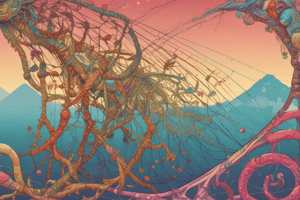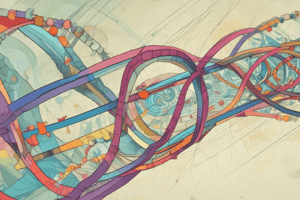Podcast
Questions and Answers
What does the Hardy-Weinberg Theorem predict about allele frequencies in a population?
What does the Hardy-Weinberg Theorem predict about allele frequencies in a population?
- They will increase over time.
- They will remain constant over time. (correct)
- They will eventually become homozygous.
- They will fluctuate significantly.
Which assumption is NOT necessary for a population to be in Hardy-Weinberg Equilibrium?
Which assumption is NOT necessary for a population to be in Hardy-Weinberg Equilibrium?
- No mutation.
- Small population size. (correct)
- No migration.
- No selection.
What role does mutation play in a population according to evolutionary theory?
What role does mutation play in a population according to evolutionary theory?
- It stabilizes allele frequencies.
- It generates new alleles. (correct)
- It eliminates harmful alleles only.
- It preserves existing alleles.
Which evolutionary force is characterized by the random preservation or elimination of alleles?
Which evolutionary force is characterized by the random preservation or elimination of alleles?
Inbreeding primarily affects the frequency of which genetic characteristic in a population?
Inbreeding primarily affects the frequency of which genetic characteristic in a population?
What would be the result of migration on a population?
What would be the result of migration on a population?
What is a main effect of non-random mating in a population?
What is a main effect of non-random mating in a population?
Which of the following is true about the Hardy-Weinberg Theorem?
Which of the following is true about the Hardy-Weinberg Theorem?
What is one reason why periodic cicadas emerge every 13 or 17 years?
What is one reason why periodic cicadas emerge every 13 or 17 years?
Which of the following is NOT an observation made regarding cicadas?
Which of the following is NOT an observation made regarding cicadas?
What drives competition among cicadas as per evolutionary thinking?
What drives competition among cicadas as per evolutionary thinking?
Which of the following represents a factor contributing to heritability in cicadas?
Which of the following represents a factor contributing to heritability in cicadas?
Darwin's theory of evolution is based on which of the following observations?
Darwin's theory of evolution is based on which of the following observations?
What best explains why different cicada broods exist?
What best explains why different cicada broods exist?
What is a likely reason for the long generation time of cicadas?
What is a likely reason for the long generation time of cicadas?
Which statement aligns with the concept of differential success in cicadas?
Which statement aligns with the concept of differential success in cicadas?
What is the ultimate source of genetic variation in populations?
What is the ultimate source of genetic variation in populations?
Which type of mutation is most significant for evolutionary change?
Which type of mutation is most significant for evolutionary change?
How can we measure the genetic variation in a population?
How can we measure the genetic variation in a population?
What is the modified formula representing the Hardy-Weinberg equilibrium for a gene with three alleles A, B, and C?
What is the modified formula representing the Hardy-Weinberg equilibrium for a gene with three alleles A, B, and C?
If p = 0.5, q = 0.3, and r = 0.2, what is the expected frequency of genotype AB based on the Hardy-Weinberg equation?
If p = 0.5, q = 0.3, and r = 0.2, what is the expected frequency of genotype AB based on the Hardy-Weinberg equation?
What is the primary estimation of genetic diversity within a population?
What is the primary estimation of genetic diversity within a population?
Which of the following statements about mutations is true?
Which of the following statements about mutations is true?
According to the Hardy-Weinberg model, what would the squared sum of allele frequencies equate to?
According to the Hardy-Weinberg model, what would the squared sum of allele frequencies equate to?
What is one reason why the Indian government prevents contact with the Sentinelese?
What is one reason why the Indian government prevents contact with the Sentinelese?
Which factor contributes to the isolation of the Sentinelese tribe?
Which factor contributes to the isolation of the Sentinelese tribe?
From a biological perspective, what is a major risk of contact with outsiders for the Sentinelese?
From a biological perspective, what is a major risk of contact with outsiders for the Sentinelese?
How long have the Sentinelese likely remained uncontacted by outsiders?
How long have the Sentinelese likely remained uncontacted by outsiders?
What is a characteristic of how the Sentinelese live?
What is a characteristic of how the Sentinelese live?
What primarily constitutes the diet of the Sentinelese?
What primarily constitutes the diet of the Sentinelese?
Which statement accurately reflects the lineage of the Sentinelese?
Which statement accurately reflects the lineage of the Sentinelese?
Which of the following is NOT a characteristic associated with the Sentinelese?
Which of the following is NOT a characteristic associated with the Sentinelese?
What genetic trait influences the survival likelihood of cicadas?
What genetic trait influences the survival likelihood of cicadas?
What does natural selection primarily focus on?
What does natural selection primarily focus on?
Which of the following describes fitness in an evolutionary context?
Which of the following describes fitness in an evolutionary context?
What is the outcome when directional selection occurs?
What is the outcome when directional selection occurs?
What happens to variation in a population undergoing stabilizing selection?
What happens to variation in a population undergoing stabilizing selection?
Which selection type occurs when both extremes of a spectrum have higher fitness than the intermediates?
Which selection type occurs when both extremes of a spectrum have higher fitness than the intermediates?
How does frequency-dependent selection affect a population?
How does frequency-dependent selection affect a population?
What is the primary effect of natural selection on a population over time?
What is the primary effect of natural selection on a population over time?
In which scenario is natural selection least likely to cause a significant change?
In which scenario is natural selection least likely to cause a significant change?
What can be inferred about cicadas that have successful larval periods?
What can be inferred about cicadas that have successful larval periods?
Stabilizing selection maintains what within a population?
Stabilizing selection maintains what within a population?
During which evolutionary process might we expect to see the greatest increase in variation?
During which evolutionary process might we expect to see the greatest increase in variation?
What is defined as 'the measurable currency' of an individual's success in contributing to future generations?
What is defined as 'the measurable currency' of an individual's success in contributing to future generations?
Flashcards are hidden until you start studying
Study Notes
Hardy-Weinberg Theorem
- Models population genetics by estimating allele and genotype frequencies.
- Requires certain assumptions for maintaining equilibrium: no mutation, no migration, no selection, and large population size.
- A population in Hardy-Weinberg Equilibrium will not evolve over time.
Evolutionary Forces
- Violations of Hardy-Weinberg assumptions lead to evolutionary changes.
- Mutation: Introduces new alleles by altering DNA sequences.
- Migration: Transfers alleles between populations; gene flow can counteract genetic drift.
- Selection: Influences which alleles are preserved based on fitness advantages.
- Genetic Drift: Random changes in allele frequencies; impacts smaller populations more significantly.
- Inbreeding: Increases frequency of homozygotes, which can reduce genetic diversity.
- Non-Random Mating: Alters distributions of traits linked to mating preferences.
Cicada Life Cycles
- Periodical cicadas (Magicicada spp.) emerge every 13 or 17 years, promoting mass emergence.
- Long generation times and synchronized emergence may evolve as strategies against predation.
- Theories about emergence patterns may suggest various evolutionary advantages.
Darwin’s Observations on Evolution
- Organisms exhibit variation in characteristics, which can be heritable.
- Competition leads to differential survival, influenced by individual fitness.
- Evolution results from the interaction of variation, heritability, competition, and differential success.
Mechanisms of Evolution
- Natural Selection: Non-random survival and reproduction based on advantageous traits.
- Types of natural selection include:
- Directional Selection: Individuals at one extreme benefit, causing shifts in traits.
- Stabilizing Selection: Intermediate traits are favored, reducing variation.
- Disruptive Selection: Extremes have advantages, increasing variation.
- Frequency-Dependent Selection: Common traits may have varying fitness based on their prevalence.
Sentinelese Tribe
- The Sentinelese are uncontacted and aggressive towards outsiders, living on North Sentinel Island.
- Estimated population ranges from 50 to 200 individuals; significant genetic isolation for 30,000-60,000 years.
- Isolation and potential risks of contact pose serious concerns for genetic diversity.
Genetic Variation and Mutation
- Mutations serve as the primary source of genetic variation and necessary for evolution.
- Germ-line mutations can be passed to offspring; a human may carry approximately 1.6 detectable mutations.
- Most coding region mutations are mildly deleterious or neutral initially.
- Genetic variation in populations is measured through heterozygosity.
Hardy-Weinberg Equations
- For a gene with three alleles (A, B, C), the frequencies can be represented as p (A), q (B), and r (C).
- The total frequency equation is (p + q + r)² = 1.
- Expected frequencies of genotypes are calculated through:
- p² = frequency of AA
- 2pq = frequency of AB
- 2pr = frequency of AC
- q² = frequency of BB
- 2qr = frequency of BC
- r² = frequency of CC.
Studying That Suits You
Use AI to generate personalized quizzes and flashcards to suit your learning preferences.




